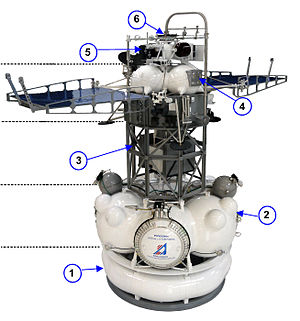Yinghuo-1
| Yinghuo-1 | ||||||||||
|---|---|---|---|---|---|---|---|---|---|---|
 The Russian Mars probe Fobos-Grunt (above) with the Fregat upper stage (below) and the cube-shaped Yinghuo-1 (No. 3) inside the lattice structure in between. |
||||||||||
| Mission goal | Mars | |||||||||
| Client | CNSA | |||||||||
| construction | ||||||||||
| Takeoff mass | 115 kg | |||||||||
| Course of the mission | ||||||||||
|
||||||||||
Yinghuo-1 ( Chinese 螢火 一號 / 萤火 一号 , Pinyin Yínghuŏ Yīhào ) was a Chinese space probe for the exploration of Mars as an orbiter .
history
The probe was developed at the Shanghai Academy of Space Technology from 2006 and completed in June 2009. The name is a play on words. Since Mars, due to its strongly fluctuating distance to the earth - between 56 and 401 million kilometers - appears sometimes more and sometimes less bright, the planet in ancient China was named 荧惑 ( also because of the red color caused by the iron oxide on its surface ( Pinyin Yínghuò ), so "glowing uncertainty". The current name 火星 (Pinyin Huŏxīng ), ie "fire star ", only appears at the beginning of the 1st century with the spread of the five-element theory that emerged during the Warring States' times . Similar to the god of war Mars in the west, the Yinghuo was considered a demon in China, the planet had strong negative connotations. Therefore, the almost equally pronounced but cute name 萤火 (Pinyin Yínghuŏ ) was chosen for the probe , meaning “firefly”, but ultimately “Mars 1”.
The probe was launched on November 8, 2011 from Baikonur as a piggyback payload of the Russian Mars probe Fobos-Grunt with a Zenit-3F rocket . The cooperation between China and Russia on this Mars mission was agreed in 2007. Since the entry into the transition orbit to Mars did not take place, the probe could not leave the parking orbit. On January 15, 2012, Yinghuo-1 entered the earth's atmosphere together with Fobos-Grunt and burned up over the Eastern Pacific.
technology
Yinghuo-1 was 0.75 x 0.75 x 0.60 m and weighed 115 kg. It should orbit Mars for two years in a highly elliptical orbit of 800 × 80,000 km with 5 ° inclination and three days of orbit. The aim was to study the surface and atmosphere of the planet. The following payloads were on board:
- Medium resolution camera for mapping purposes
- High resolution camera (200 m per pixel) for detailed photos
- Fluxgate magnetometer (measuring range: around 256 nT , resolution: 0.01 nT)
- Plasma analyzer for electrons (charge) and ions (charge and mass)
- Radio receiver for measuring the attenuation of the signals from Fobos-Grunt (416.5 MHz and 833 MHz) by the Mars ionosphere
The data transmission should take place in the S-band with an antenna about one meter in size, 12 watts of transmission power and a data transmission rate of 2500 bps . The two three-part solar cell booms had a span of 5.6 m and should deliver an average of 90 watts.
Others
After the mission failed, Yinghuo-1 was barely mentioned in the Chinese media for years. However, when the second Mars probe Tianwen-1 took place on August 25, 2020, the 7th day of the 7th month according to the lunar calendar, i.e. the one day of the year on which the cowherd and weaver meet across the Elsternbrücke , a distance of exactly 10 million Reached kilometers from Earth (and the rover Jade Bunny 2 had spent exactly 600 days on the moon), the National Space Agency of China published the following poem, referring to an old saying that said someone who passed the imperial palace exam - the highest Level of the official examination - passed, from now on serving on the moon:
|
蟾宫 折桂 , 月 背 拓荒 ; |
Chángōng zhé guì, yuèbēi tuò huāng; |
We pick osmanthus blossoms in the palace of the moon toad, we clear the back of the satellite; |
See also
Web links
- “Yinghuo-1” - Martian Space Environment Exploration Orbiter (English; PDF; 22 kB)
- Magnetic Field Experiment on Yinghuo-1 at Mars , bibcode : 2008cosp ... 37.3634Z (English)
- Brief introduction about Chinese martian mission Yinghuo-1 (English; PDF; 611 kB)
- Yinghuo will fly - but where to? ( Telepolis )
Individual evidence
- ↑ 中俄 航天 首次 联合 探测 火星 “萤火 一号 发射” 圆满 成功. In: cgwic.com. November 9, 2011, accessed July 19, 2020 (Chinese).
- ↑ China's first Mars probe is ready
- ↑ 罗 竹 风 (主编): 汉语大词典.第七卷. 汉语大词典 出版社, 上海 1994 (第二 次 印刷), pp. 10 and 216.
- ↑ 刘 茜: Mars 最早 的 中文 名 —— “荧惑”. In: cnsa.gov.cn. July 17, 2020, accessed July 19, 2020 (Chinese).
- ↑ 航天 局 : 我国 "萤火 一号" 火星 探测器 将于 11 月 发射. In: gov.cn. October 21, 2011, accessed July 28, 2020 (Chinese).
- ↑ 王 赤 et al .: 中国 月球 及 深 空 空间 环境 探测. In: jdse.bit.edu.cn. March 30, 2019, accessed July 28, 2020 (Chinese).
- ↑ FliegerRevue September 2009, p. 9, China's Mars probe Yinghuo 1
- ↑ China plans to go to Mars ( Memento from February 11, 2009 in the Internet Archive )
- ↑ “来自 星星 的 七夕 大礼” : 天 问 一号 距离 地球 超 1000 万 公里 , 嫦娥 四号 工作 满 600 天! In: spaceflightfans.cn. August 25, 2020, accessed August 26, 2020 (Chinese).
